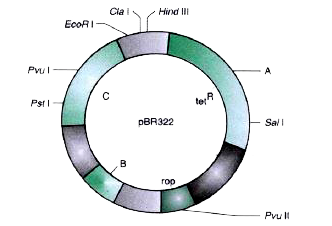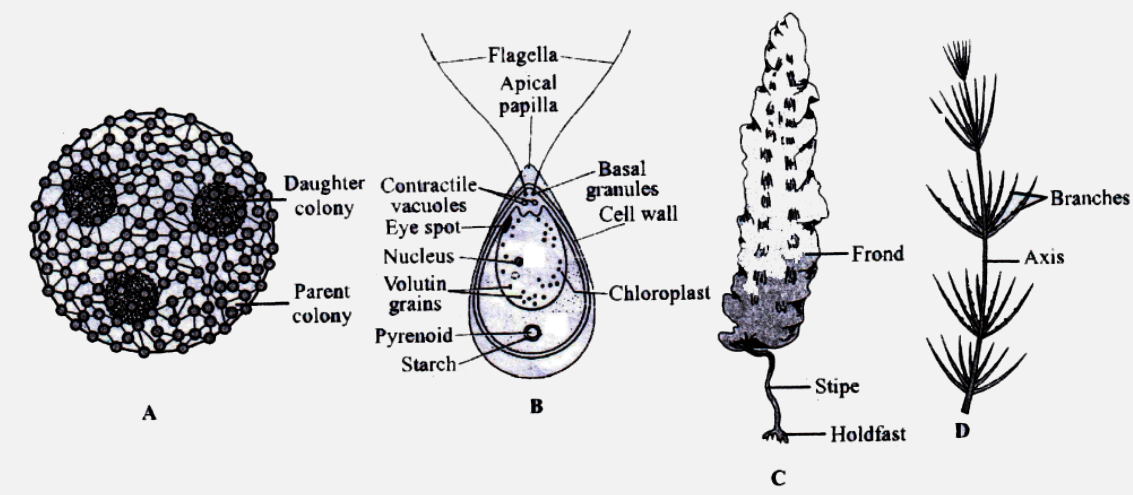Name the regions marked A, B and C.

A-Testosterone, B-Spermatogenesis, C-Sertoli cells, D-Spermiogenesis
Topper's Solved these Questions
- HUMAN REPRODUCTIONBOOK - ICSECHAPTER - HUMAN REPRODUCTIONEXERCISE - PRACTICE QUESTIONS (SHORT ANSWER TYPE-II QUESTIONS)
20 Videos
- HUMAN REPRODUCTIONBOOK - ICSECHAPTER - HUMAN REPRODUCTIONEXERCISE - PRACTICE QUESTIONS (LONG ANSWER TYPE QUESTIONS)
9 Videos
- HUMAN REPRODUCTIONBOOK - ICSECHAPTER - HUMAN REPRODUCTIONEXERCISE - PRACTICE QUESTIONS (VERY SHORT ANSWER TYPE QUESTIONS)
28 Videos
- HUMAN HEALTH AND DISEASE BOOK - ICSECHAPTER - HUMAN HEALTH AND DISEASE EXERCISE - COMPETITION CORNER (OBJECTIVE TYPE QUESTIONS) (Assertion and Reason Type Questions (For AIIMS aspirants))
28 Videos
- ISC BOARD PAPER (2019 -BIOLOGY)BOOK - ICSECHAPTER - ISC BOARD PAPER (2019 -BIOLOGY)EXERCISE - PART-II ( SECTION-C)
12 Videos
Similar Questions
Given is the ultrastructure of an animal cell. Identify the parts marked as A, B, C and D.

View Solution
The diagram alongside shows an arrangement of three pulleys A,B and C. the load is marked as L and the effort as E.
(a) Name the pulleys A,B and C.
(b) Mark in the diagram the directions of load (L), effort (E) and tension T1andT2 in the two strings.
(c) How are the magnitudes of L and E related to the tension T1 ?
(d) Calculate mechanical advantage and velocity ratio of the arrangement.
(e) What assumptions have you made in parts (c) and (d) ?
View Solution
Knowledge Check
Consider a one-dimensional motion of a particle with total energy E. There are four regions A, B, C and D is which the relation between potential energy U, kinetic energy (K) and total energy E is as given below
RegionA:U>E Region B:U<E
Region C:K<E Region D:U>E
State with reason in each case whether a particle can be found in the given region or not.ARegion ABRegion BCRegion CDRegion D
The following diagram represents the human brain as seen in an external view. Study the same and then answer the questions that follow :

(i) Name the part labelled A, B, C and D.
(ii) Mention the difference in the arrangement of the nerve cells in the parts marked 'A' and 'D'
(iii) What is the main function of the parts marked 'C and 'D'?
(iv) Name the sheet of nerve fibres that connect the two halves of the part labelled.
(v) Name the basic unit of brain.
View SolutionExamine the figure

(a) Is this structure present in animal cell of plant cell ?
(b) Can these be passed on to the progeny? How ?
( c) Name the metabolic processes taking place in the places marked (A) and (B).
View SolutionIdentify the figures given below marked as A,B,C and D.

View SolutionA box contains a certain number of balls. Some of these balls are marked A, some are marked B and the remaining's are marked C. When a ball is drawn at random from the box P(A)=13andP(B)=14. If there are 40 balls in the box which are marked C, find the number of balls in the box.
View SolutionConsider a one-dimensional motion of a particle with total energy E. There are four regions A, B, C and D is which the relation between potential energy U, kinetic energy (K) and total energy E is as given below
RegionA:U>E Region B:U<E
Region C:K<E Region D:U>E
State with reason in each case whether a particle can be found in the given region or not.
View SolutionName the blank spaces a, b, c and d

View Solution
Name the parts a, b, c and d.
View Solution
